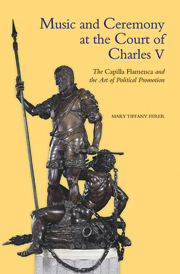 Music and Ceremony at the Court of Charles V
Music and Ceremony at the Court of Charles V Book contents
- Frontmatter
- Contents
- List of Illustrations
- List of Tables
- Preface and Acknowledgements
- List of Abbreviations
- Dedication
- Chapter 1 Charles V: Defender of the Faith and Universal Monarch
- Chapter 2 The Genesis of the Chapel
- Chapter 3 The Reconstruction of the Capilla Flamenca
- Chapter 4 The Chapel Ordinances: Ritual and Repertory at the Court
- Chapter 5 Music and Ceremony at the Court of Charles V
- Chapter 6 Charles V as Crusader and Christian Knight
- Chapter 7 The Presentation of the Emperor
- APPENDIX A Chapel Rosters
- APPENDIX B Chapel Statutes and Ordinances
- APPENDIX C Selected Chapel Personnel
- APPENDIX D Musical Manuscripts, Prints, and Editions
- Glossary
- Bibliography
- Index
Chapter 7 - The Presentation of the Emperor
Published online by Cambridge University Press: 05 October 2013
- Frontmatter
- Contents
- List of Illustrations
- List of Tables
- Preface and Acknowledgements
- List of Abbreviations
- Dedication
- Chapter 1 Charles V: Defender of the Faith and Universal Monarch
- Chapter 2 The Genesis of the Chapel
- Chapter 3 The Reconstruction of the Capilla Flamenca
- Chapter 4 The Chapel Ordinances: Ritual and Repertory at the Court
- Chapter 5 Music and Ceremony at the Court of Charles V
- Chapter 6 Charles V as Crusader and Christian Knight
- Chapter 7 The Presentation of the Emperor
- APPENDIX A Chapel Rosters
- APPENDIX B Chapel Statutes and Ordinances
- APPENDIX C Selected Chapel Personnel
- APPENDIX D Musical Manuscripts, Prints, and Editions
- Glossary
- Bibliography
- Index
Summary
CHARLES V AND IMAGES IN THE VISUAL ARTS
The most enduring image of Charles V, Titian's famous equestrian portrait of the emperor, now hangs in the Museo del Prado in Madrid. It was commissioned following the decisive victory over the Protestants at Mühlberg in 1547. Titian has been careful to capture the details of the event realistically. Charles rides his own horse and wears his own armour as he did on the day of the battle. According to eyewitnesses, the cloudy sky, tinged with streaks of red (a bloody sun according to some commentators), is exactly as it looked on the morning of the victory when, at a crucial point in the battle, imperial troops crossed the river Elbe seen in the background. Charles wears the collar of the Order of the Golden Fleece as the Defender of the Faith against the heretic, and he is depicted as the heroic Crusader, the miles Christi (knight or soldier of Christ) holding a lance, a symbol of medieval knighthood.
The lance can also be read as a reference to the Holy Roman Empire. As the Lance of St Maurice, patron saint of the Empire, it was a relic particularly venerated by the Holy Roman Emperors, who had acquired it from Charlemagne. Masses in honour of the Holy Lance were traditionally celebrated in the Empire on the Friday following the Octave of Easter. St Maurice was also the patron saint of the Order of the Golden Fleece in Spain, and the Holy Lance in Titian’s painting can be understood, along with the collar of the Order which Charles wears, as an evocation of the emperor as the Defender of the Faith and Christian knight as well as a reference to Northern traditions of medieval chivalry.
- Type
- Chapter
- Information
- Music and Ceremony at the Court of Charles VThe Capilla Flamenca and the Art of Political Promotion, pp. 221 - 240Publisher: Boydell & BrewerPrint publication year: 2012
